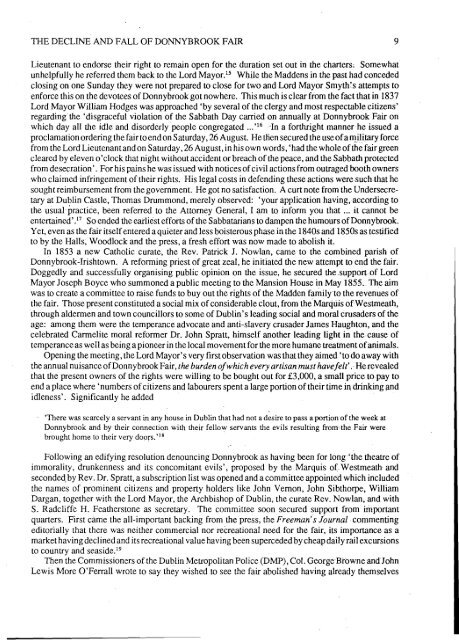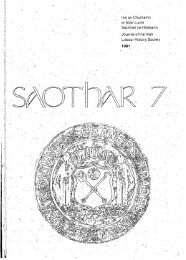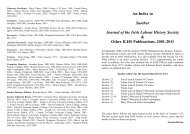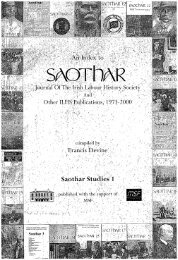8 SAOTHAR 13to the Rakes of Mallow played by a fiddler getting steadily drunker. It is clear from the absence ofreferences in the police and judicial records or in the press reports that the wilder excesses of theeighteenth century were not a feature of the occasion: as a press report of 1823 noted:'notwithstanding the immense numbers that attended, there were comparatively few rows ... some blackeyes were given and taken but a hearty apology and the 'deoch an dorais' made all well again.'IOThis was probably typical of the time. When the Halls visited Ireland a decade or so later they founda much quieter scene at Donnybrook:'We heard nothing and noticed nothing that could offend the most scrupUlous: there was no quarrellingapproaching to a brawl; wedid not encounter a single intoxicated person of either sex, and enquiry a~policeoffices the next day revealed 'no charges preferred'. '11Their findings were echoed in the private comments of the Dublin police magistrate WilliamWoodlock who kept a diary during this period. In 1854 he confided:'Fri 25 August. After my dip, walked to Donnybrook to look at the Fair. 'Alas for my country, her prideis gone by!' It was woefully quiet, almost respectable. There was no fun, no fighting, no drunkenness, orat least very little of it. The shows were just what fair shows may be expected to be anywhere, tawdry andcommonplace.' 1 2 'And in the very year that Woodlockmade his diary entry the reporter for theFreeman' s Journal gaveconvincing support to the accuracy of Woodlock's comment:'Alas for the glories of the 'Brook': less and less have they become each year and we should not feel muchsurprised if ... we were called upon ere long to record their being numbered wilh the things that were ... Thefair this year is worth no more than a passing mention. q 3Whatever had happened in the space of twenty years? The answer to this is that a revolution hadhappened. This revolution involved a relatively rapid and quite decisive breakthrough in terms of moralreform and social control of the common people of Dublin. The agents of this breakthrough werechurches and state, separately and together, through religious revival, temperance crusading and policereorganisation .. A determined, sometimes combined effort was made to civilise and moralise themasses, to imbue them with the mores of the ascending middle classes, and to prise them from theirtraditional attachment to rough sports and physical assertiveness. This effort directed itself with specialenergy to the abolition of Donnybrook Fair, once a festival, now increasingly an affront.Already as early as 1802 when the evangelical revival was beginning to gather pace, the writer HelyDutton introduced one of the first sharp notes of moral indignation:'Donnybrook Fair has long been complained of as a nuisance and a most dangerous one it is ... the scenesof riot and drunkenness that take place there are most disgusting arid can surely answer no purpose but toput money into the pockets of publicans at the expense of the morals and health of the people ... 'and, he concluded, 'I sincerely hope to see it abolished before the next meeting' .14 Although his hopewas not to be realised for a very long time, it became one that was shared increasingly by others, in therising tide of the evangelical revival. One of the key features of that revival was a strengthening waveofsabbatarianism. It was against this background that Lord Mayor Richard Smyth in the early 1820stried to have the fifteen days of Donnybrook Fair interrupted in order to secure the observance of theSabbath. He claimed that the fair was 'most fatal to the peace and happiness of the humbler classes'.The owners of the rights, John and Peter Madden, refused to comply and appealed to the Lord
<strong>THE</strong> DECLINE AND FALL <strong>OF</strong> DONNYBROOK FAIR 9Lieutenant to endorse their right to remain open for the duration set out in the charters; Somewhatunhelpfully he referred them back to the Lord Mayor.15 While the Maddens in the past had concededclosing on one Sunday they were not prepared to close for two and Lord Mayor Smyth'.s attempts toenforce this on the devotees of Donnybrook got nowhere. This much is clear from the fact that in 1837Lord Mayor WiIliam Hodges was approached 'by several of the clergy and most respectable citizens'regarding the 'disgraceful violation of the Sabbath Day carried on annually at Donnybrook Fair onwhich day all the idle and disorderly people congregated .. .'16 'In a forthright manner he issued aproclamation ordering the fair to end on Saturday, 26 August. He then secured the useof a Illilitary forcefrom the Lord Lieutenant and on Saturday, 26 August, in his own words, 'had the whole of the fair greencleared by eleven 0' clock that night without accident or breach of the peace, and the Sabbath protectedfrom desecration'. For his pains he was issued with notices of civil actions from outraged booth ownerswho claimed infringement of their rights. His legal costs in defending these actions were such that hesought reimbursement from the government. He got no satisfaction. A curt note from the Undersecretaryat Dublin Castle, Thomas Drummond, merely observed: 'your application having, according tothe usual practice, been referred to the Attorney General, I am to inform you that ... it cannot beentertained' .17 So ended the earliest efforts of the Sabbatarians to dampen the humours of Donnybrook.Yet, even as the fair itself entered a quieter and less boisterous phase in the 1840s and 1850s as testifiedto by the Halls, Woodlock and the press, a fresh effort was now made to abolish it.In 1853 a new Catholic curate, the Rev. Patrick J. Nowlan, came to the combined parish ofDonnybrook-lrishtown. A reforming priest of great zeal, he initiated the new attempt to end the fair.Doggedly and successfully organising public opinion on the issue, he secured the_support of LordMayor Joseph Boyce who summoned a public meeting to the Mansion House in May 1855. The aimwas to create a committee to raise funds to buy out the rights of the Madden family to the revenues ofthe fair. Those present constituted a social mix of considerable clout, from the Marquis of Westmeath,through aldermen and town councillors to some of Dublin's leading social and moral crusaders of theage: among them were the temperance advocate and anti-slavery crusader James Haughton, and thecelebrated Carmelite moral reformer Dr. John Spratt, himself another leading light in the cause oftemperance as well as being a pioneer in the local movement for the more humane treatment of animals.Opening the meeting, the Lord Mayor's very rust observation was that they aimed 'to do away withthe annual nuisance of Donnybrook Fair, the burden o/which every artisan must have/elt'. -He revealedthat the present owners of the rights were willing to be bought out for £3,000, a small price to pay toend a place where 'numbers of citizens and labourers spent a large portion of their time in drinking andidleness'. Significantly he added'There was scarcely a servant in any house in Dublin that had not a desire to pass a portion of the week atDonnybrook and by their connection with their fellow servants the evils resulting from-·the Fair werebrought home to their very doors.'18Following an edifying resolution denouncing Donnybrook as having been for long 'the theatre ofimmorality, drunkenness and its concomitant evils', proposed by the Marquis of Westmeath andseconded, by Rev. Dr. Spratt, a subscription list was opened and a committee appointed which includedthe names of prominent citizens and property holders like John Vernon, John Sibthorpe, WilIiamDargan, together with the Lord Mayor, the Archbishop of Dublin, the curate Rev. Nowlan, and withS. Radcliffe H. Featherstone as secretary. The committee soon secured support from importantquarters. First came the all-important backing from the press, the Freeman's journal commentingeditorially that there was neither commercial nor recreational need for the fair, its importance as amarket having declined and its recreational value having been superceded by cheap da:ily rail excursionsto country and seaside,I9Then the Commissioners of the Dublin Metropolitan Police (DMP), Col. GeorgeBrowne and JohnLewis More O'Ferrall wrote to say they wished to see the fair abolished having already themselves
- Page 1 and 2: JOURNAL OF THE IRISH LABOUR HISTORY
- Page 3 and 4: ContentsPageEditorial: Labour Histo
- Page 5 and 6: EDITORIAL 3freedom to participate i
- Page 7 and 8: CorrespondenceThe Irish Labour Part
- Page 9: ; ~ ; ,The Decline and Fall of Donn
- Page 13 and 14: THE DECLINE AND FALL OF DONNYBROOK
- Page 15 and 16: ·' THE DECLINE AND FALL OF DONNYBR
- Page 17 and 18: THE DECLINE AND FALL OF DONNYBROOK
- Page 19 and 20: THE DECLINE AND FALL OF DONNYBROOK
- Page 21 and 22: THE DECLINE AND FALL OF DONNYBROOK
- Page 23 and 24: THE DECLINE AND FALL OF DONNYBROOK
- Page 25 and 26: ,'-,;-''''.A PASSAGE TO BRITAIN 23C
- Page 27 and 28: A PASSAGE TO BRITAIN 25only in the
- Page 29 and 30: A PASSAGE TO BRITAIN 27clothing._De
- Page 31 and 32: A PASSAGE TO BRITAIN 29established
- Page 33 and 34: ;:-.",.- .. .", ...... '.:. '
- Page 35 and 36: LOUIE BENNETI 33feminist movement w
- Page 37 and 38: :... ~: ."
- Page 39 and 40: -.- '.LOUlE BENNETT 37While there i
- Page 41 and 42: LOUIE ~ENNEIT 39Xl's encyclical Qua
- Page 43 and 44: LOUIE BENNEIT 41Bennett's own relat
- Page 45 and 46: LODIE BENNETT 43109; IWWU resolutio
- Page 47 and 48: Essays in ReviewCosherers, Wanderer
- Page 49 and 50: ••• .".'. >. '~"ESSA YS IN RE
- Page 51 and 52: ESSAYS IN REVIEW 49ConnolIy:Myth an
- Page 53 and 54: ESSAYS IN ~EVIEW 51tion' in the Int
- Page 55 and 56: ESSAYS IN REVIEW53International:'I
- Page 57 and 58: REVIEWScontroversy is real history.
- Page 59 and 60: REVIEWSJoe Monks was among the earl
- Page 61 and 62:
REVIEWSnolly-Column Song','Proudly
- Page 63 and 64:
REVIEWSresulting from the arrival o
- Page 65 and 66:
REVIEWS,63the book by means of an a
- Page 67 and 68:
REVIEWSlogue, it is hardly surprisi
- Page 69 and 70:
The Team For All Workers ...CULIAIB
- Page 71 and 72:
ESSAYS 69mission and moral refonn.l
- Page 73 and 74:
.. ...... ~.~ -~ .'- '.ESSAYS. 71fr
- Page 75 and 76:
ESSAYS 73claimed authority but whic
- Page 77 and 78:
ESSAYS 75provided the basis for soc
- Page 79 and 80:
ESSAYS 779. For comparisons see E.T
- Page 81 and 82:
ESSAYS 7952. Annals of Christ Churc
- Page 83 and 84:
ESSAYS' 81Fianna Fail and the Worki
- Page 85 and 86:
ESSAYS 83Eireann in 1925 visibly di
- Page 87 and 88:
ESSAYS 85recognition of the impract
- Page 89 and 90:
ESSAYS 871970, it created the condi
- Page 91 and 92:
ESSAYS89The Irish Immigrants' Contr
- Page 93 and 94:
ESSAYS" 91Although anti -Catholic p
- Page 95 and 96:
ESSAYS 93McCowie played a key role
- Page 97 and 98:
:. -,,'.' ',. .~.,:.ESSAYS 95Althou
- Page 99 and 100:
ESSAYS 97young girl of their own ba
- Page 101 and 102:
SourcesIrish Labour History Society
- Page 103 and 104:
SOURCES 101INovember, 1971 to no. 1
- Page 105 and 106:
SOURCES 103would claim credit for t
- Page 107 and 108:
SOURCES105Sources for Irish Labour
- Page 109 and 110:
SOURCES 107NorthWest Archives and L
- Page 111 and 112:
SOURCES 109In 1966 the Finnish gove
- Page 113 and 114:
TURNINGANEWLEAFThe CPSSUis the larg
- Page 115 and 116:
REMINISCENCE 113us due to my politi
- Page 117 and 118:
REMINISCENCE 115when Jim was presen
- Page 119 and 120:
REMINISCENCE 117of Dail Eireann. 17
- Page 121 and 122:
REMINISCENCE 119NotesThe above arti
- Page 123 and 124:
DOCUMENT STUDY 121James Connolly in
- Page 125 and 126:
DOCUMENT STUDY123SOCIAL DEMOCRATIC
- Page 127 and 128:
DOCUMENT STUDY 125proletariat of th
- Page 129 and 130:
DOCUMENT STUDY 127the support of Je
- Page 131 and 132:
DOCUMENT STUDY 12926. The Workers'
- Page 133 and 134:
131BibliographyA Bibliography of Ir
- Page 135 and 136:
BIBLIOGRAPHY 133Compton, P.A. Demog
- Page 137 and 138:
BIBLIOGRAPHY 135Levine, I. and Madd
- Page 139 and 140:
BIBLIOGRAPHY 137Turner, M. 'Towards
- Page 141 and 142:
BIBLIOGRAPHY 1394. Land and Agricul
- Page 143 and 144:
BIBLIOGRAPHY 141Clogher Record12 (2
- Page 145 and 146:
BIBLIOGRAPHY 143Political Research
- Page 147 and 148:
BIBLIOGRAPHY 145Pres, 1987.O'Brien,
- Page 149 and 150:
147Notes on Contributorsf onathanBe
- Page 151 and 152:
1901: Ireland's first general union
- Page 153 and 154:
ELECTRICAL TRADES UNION .Establishe





